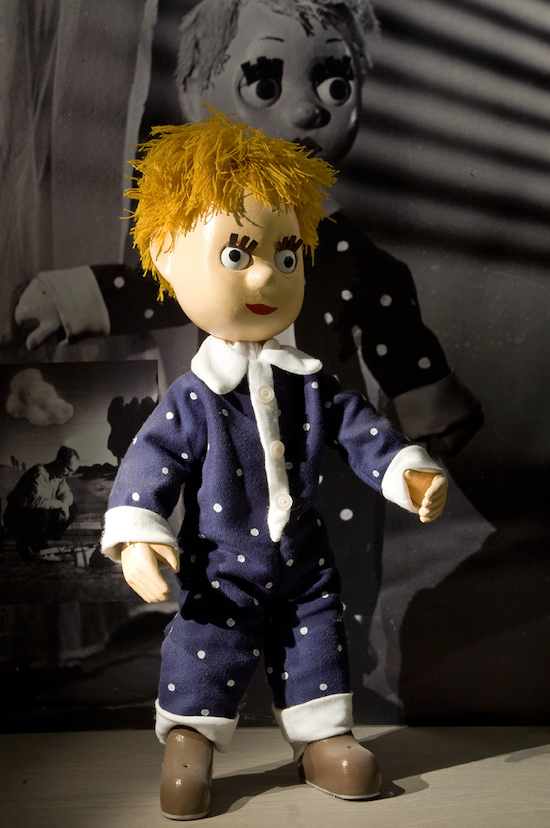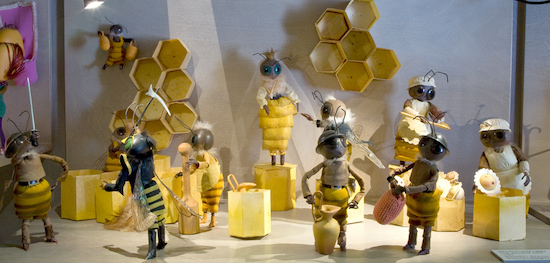Puppets from the puppet film "Meemeistrite linn (1983)
The permanent exhibition at Tartu Mänguasjamuuseum (‘Tartu Toy Museum’) on Estonian animation is housed in the courtyard house, below the floors assigned for temporary exhibitions. I had arrived in Tartu to present a piece for the seminar of Tartu Loomemajanduskeskus (‘Centre for Creative Industries’) for the tenth anniversary of the organisation which has just been part of securing a successful bid for the town to be European Capital of Culture in 2024. The series of events at Kalevi, which carried on to the twelfth of October included ‘Celluloid Music’, screenings of Estonian animation on 16mm from a personal collection by a local cine-enthusiast, Paavo Mardi, which included Eine Murul (‘Breakfast on the Grass’, 1987).
This contribution by an independent collector is of huge value to the history of film in terms of both dissemination and archiving. Internationally, it is only recently that film history has been recognised for its level of cultural contribution by state collections. For example, in the UK, many early films were melted down for munitions and it was only with the establishment of the Imperial War Museum at the end of the First World War that state film archiving began. My background studying early film has led to me appreciate the efforts of enthusiasts as well as the film-makers. Contemporary artists, such as Tacita Dean, can build their career on the backs of these collectors who have conveyed their appreciation for the beauties of obsolete celluloid beyond the limited circles of special interest.
Estonian creators have produced a wide range of animation that remains pretty much unknown in the UK. At the time of release, these films may have never been shown on television, only at art festivals. After these public events, these productions of the Soviet-era state monopoly, Tallinn Films, were shelved in the vaults. To see many of these films is a rare experience. A large number of the animations made on film have never been telecined. This programme was organised DJ Ahto Külvet, the proprietor of vinyl store Psühhoteek and force behind Psühhodisko, lectures and events presenting Estonian and other overlooked music from the Eastern Bloc. His work is part of a general revival in the country of music and creativity that managed to flourish amidst extreme centralisation and censorship.
A first trip to the Toy Museum offered a quick education in Estonian animation, introducing me to a range of works and makers. Sketches and drafts of Estonian cartoons are displayed alongside original puppets and a loop of selected films which have been made in Estonia since 1957. The country is considered to be a hotbed of experimental animation with Priit Pärn and Rein Raamat the best known among many other admired artists.

Very first Estonian animation puppet called Peetrike (copy made for Tartu Toy Museum) from the puppet film "Peetrikese unenägu" (1958)
The first Estonian experimental short was Kutsu-Juku seiklusi (‘Adventures of Juku the Dog’, 1931) produced by Voldemar Päts. But as this is a toy museum, the emphasis is on the puppet era, where the objects can be displayed alongside the film. This feels like the beginning of modern Estonian animation, certainly in terms of the quantity of production. Despite the clunky movements that even the best puppets displayed in the 1950s and 1960s, it is a relatively quick way of producing moving pictures. Elbert Tuganov (with a young Rein Raamat) produced Peetrikese unenägu (‘Little Peter’s Dream’) made with classical puppets from the Estonian National Puppet Theatre. With this twenty minute feature (considered far too long at the time), the studio Nukufilm was founded. It still operates today, with Elbert Tuganov and Heino Pars two of its major directors. Tuganov, who is known as the father of Estonian animation, was actually born in Baku, Azerbaijan and began his animation career in Germany.
A selection of his original puppets are on display here, but others are held and displayed at the Nuku Theatre Museum in Tallinn. Having passed through on my way to the train I had been impressed by the crowds of children eager to see a shadow puppet production. The two museums are complementary – anyone with an interest in one would gain from visiting the other. Both detail the histories as well as offering interactive exhibits for children to engage. It’s a story that takes dark and charming turns as for decades so many talented filmmakers and theatre professionals were wise to work in children’s media for fear of state reprisal in the course of political moves against artists. Children’s media and, in particular, animation proved to be a safer place for individual, anti-authoritarian talent. In 2019, histories of Estonian animation discuss how the studios operated beneath the threat of menacing bureaucracy before 1991 when the country regained its independence.

Puppets from the puppet film "Kunskmoor ja kapten Trumm" (1978)
But when freedom arrived, money from Moscow was no longer available. In 1994, Tallinn Films stopped receiving funding. Nukufilm (specialising in puppet animation) and Joonisfilm (cel animation) became independent companies. The most successful Estonian animation is Lotte, a cartoon about the adventures of a young girl dog, screened here as part of a loop of films. I admit I would never have seen it otherwise as it doesn’t appeal to me so much as the work of the Soviet era, with its obsession with space, odd science and animating the inanimate, making visible what cannot be seen – like Aatomik (‘Atomic’, 1970), a puppetoon piece by Tuganov. In this latter film, a crazy little creature, a kind of friendly, micro-Frankenstein monster, fizzes and springs in a piece that uses the clunkiness of puppets to convey the mechanics of physics in the laboratory, the factory, and the invisible world. In this piece, releasing unknown forces from the interior of the atom is naughty, cute and playful. It can be seen as a metaphor for the animators themselves, producing wonderful new modern designs in secret, tapping into unlimited subversive power that threatens to bring down the restrictive edifices of society, crumble mighty institutional structures into dust. Even when the overarching narrative of the exhibition is not spelt out, it’s there for those who want to find it. This is a twentieth-century tale, told by marionettes, for adults as well as children.
When I talk about Tuganov, Ahto Külvet points me in the direction of a film made about him and Pars by fellow animators led by director Mait Laas currently available online. Ajameistrid (‘Kings of Time’, 2008), a characterful insight to these two stellar influences comparing their efforts and achievements to those of the cosmonauts of the day, reaching beyond the earth’s atmosphere. This is taken from the newsfilms of the 1950s describing Pars and Tuganov as “the first Estonians who have flown all the way to the roof of world cinema . . . “ The film, controversially, sheds light on how close Tuganov’s links were to Moscow.
But the outstanding highlight of the weekend was a talk by the genius Olav Ehala, known for his compositions for the magical Estonian children’s film Nukitsamees (‘Bumpy’, 1981) and his collaborations with Priit Pärn, known for his incredible oeuvre of dark, psychedelic, disturbing, beautiful, odd animations. Ehala described aspects of his work, and how he and fellow musicians had to be innovative in dealing with technical problems with low tech solutions. Strategies such as playing live to the final animation enhanced his jazz-influenced scores featuring melismatic female vocals. He has continued to work on many children’s films and musical theatre.
There was huge excitement in the room. The composer had driven specially from the capital city of Tallinn that evening to share his thoughts with enthusiasts in Tartu, even though the same evening there was a party at the conservatoire where he would have been celebrated. It was a heartwarming group and I was content to be part of this optimistic town on the edge of the EU.


